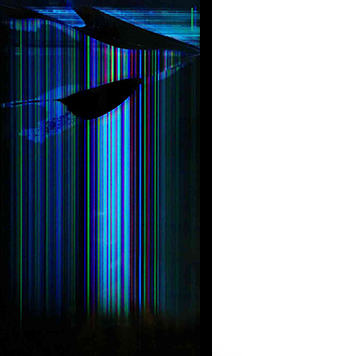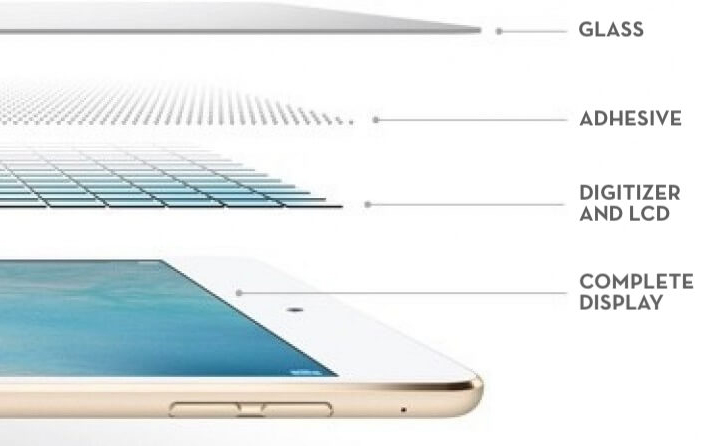 We know how hard it is to pick up a phone or tablet after a fall to find cracked glass or a broken LCD screen, but what is the difference between getting the glass repaired and the LCD repaired? It comes from how a display is assembled (some devices have LED or OLED displays, but for the purpose of this article we will just write LCD). Most cell phone manufacturers create displays with the glass and LCD components adhered together into one display: the glass sits on top of the LCD screen. The LCD also has an integrated digitizer component which is what allows the touch function to work. During both a glass repair and an LCD repair, the full display is replaced; however, there is a price difference between a glass repair and an LCD repair because good LCDs hold value independently of the glass.
We know how hard it is to pick up a phone or tablet after a fall to find cracked glass or a broken LCD screen, but what is the difference between getting the glass repaired and the LCD repaired? It comes from how a display is assembled (some devices have LED or OLED displays, but for the purpose of this article we will just write LCD). Most cell phone manufacturers create displays with the glass and LCD components adhered together into one display: the glass sits on top of the LCD screen. The LCD also has an integrated digitizer component which is what allows the touch function to work. During both a glass repair and an LCD repair, the full display is replaced; however, there is a price difference between a glass repair and an LCD repair because good LCDs hold value independently of the glass.
 What do we mean by LCDs hold value? On glass and LCD assemblies, the LCD carries a value if it still functions, even if the glass on top of it is cracked. If the LCD still works, it can be used again. Companies buy cracked glass with working LCDs to refurbish them: they separate the glass from the LCD and digitizer, replace the glass with a new piece on top of the old LCD, and sell the refurbished screen elsewhere. Therefore, repair stores can sell good, functioning LCDs to refurbishing companies. Selling cracked glass with good LCDs helps offset the cost of glass repairs, which in turn makes getting your glass fixed cheaper for you!
What do we mean by LCDs hold value? On glass and LCD assemblies, the LCD carries a value if it still functions, even if the glass on top of it is cracked. If the LCD still works, it can be used again. Companies buy cracked glass with working LCDs to refurbish them: they separate the glass from the LCD and digitizer, replace the glass with a new piece on top of the old LCD, and sell the refurbished screen elsewhere. Therefore, repair stores can sell good, functioning LCDs to refurbishing companies. Selling cracked glass with good LCDs helps offset the cost of glass repairs, which in turn makes getting your glass fixed cheaper for you!
However, if the digitizer or LCD is also damaged during a fall, that screen no longer carries value because it cannot be refurbished. Repair shops cannot sell broken LCDs to refurbishing companies; therefore, they cannot offset the cost of an LCD repair. That is why repair stores often charge a little extra if there is damage to the LCD or digitizer, to make up for that loss. Repair stores that don’t have an additional charge for an LCD repair typically inflate their glass repair price to make up for the loss from damaged LCDs. If they have one price, that means everyone is paying more to cover the cost of customers who have damaged LCDs and customers who only have cracked glass. This is why TCR separates the price of glass and LCD repairs for you! If you only have cracked glass, you only have to worry about paying to replace the cracked glass.
Here is some more information on the symptoms of cracked glass versus damaged LCDs or digitizers.
Shattered Glass
If your phone or tablet’s glass is shattered there will be cracks or chips on the screen itself. If it is just the glass that is damaged, the device may still function and you may be able to use it normally. If this is the case, it is likely that only the glass needs to be replaced. To prevent further damage to your device it is best to get it repaired quickly. For example, if liquids seep through the cracks it could cause permanent damage to the LCD.
Touchscreen Doesn’t Work
Many people may continue to use their touchscreen with shattered glass and delay fixing the glass on their devices; however, if the touchscreen isn’t responsive, it could be a sign of more significant damage to the device’s digitizer which is integrated with the LCD screen.
Pixelated Screen
A pixelated screen can indicate LCD damage. This would look like a patch of multicolored dots, a line or lines of discoloration, or a screen with rainbow colors. For many people, these colors are an easy way to know that their LCD is broken and that they should get it repaired.
Dropping your phone isn’t the only reason you’ll end up with a pixelated screen. Over time, your screen’s LCD may break down through regular use. This happens to other devices aside from your smartphone or tablet. Pixelation can happen to TVs and computers, too. People typically decide to buy a new device when this happens. Fortunately, with an LCD repair, you can fix the device without needing to replace it.
Black Screen
A black screen or black spots on your smartphone or tablet is an indication of a damaged LCD. Often with a bad LCD, a phone may still turn on and make noises, but there is no clear picture. This does not necessarily mean any other part of the phone is damaged and a simple screen replacement will get it functioning again. Sometimes it can mean a battery or other internal component is damaged. It is best to have a highly qualified phone repair technician diagnose what is wrong so the appropriate repair can be made.
Fortunately, your mobile device is fixable whether you cracked the glass or damaged the LCD. Stop by or call TCR: Triangle Cellular Repair at (919) 263-2699 for a free diagnostic and quick, affordable cell phone repair in Chapel Hill and surrounding areas. We’re always happy to help!
